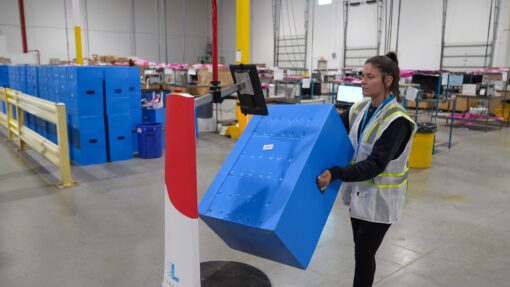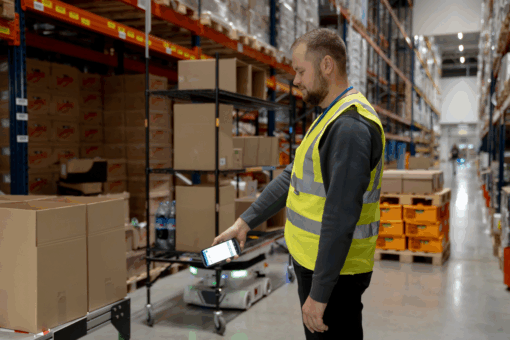WP: How to achieve 400 UPH with Locus Fast Pick
WP: How to achieve 400 UPH with Locus Fast Pick Download Now!
AGV vs AMRs: Addressing labor shortage and efficiency
Mary Hart, Sr. Content Marketing Manager

Warehouse managers have more robotics options than ever for automating their warehouse’s product transport and order fulfillment. With labor shortages and the need for faster throughput, technologies like AMRs (meaning robots that are autonomous) and automated guided vehicles (AGVs) both aim to drive efficiency and productivity. How can you determine the difference between AMRs and AGVs and choose the right robotics solution for your facility? This blog will address amr agv meaning, as well as amr agv definitions and how it can help your warehouse efficiency!
AGV Definition and Use for Warehouses
AGVs have been used in warehouses since the 1950s. At Barrett Electronics in Illinois, a tow truck followed a wire on the floor to move items.
Today’s solutions aren’t all that different from their predecessors. They follow designated paths marked out on facility floors using magnetic strips, wires or reflective tape. They rely on these fixed guides that are akin to train tracks to navigate predetermined routes around the warehouse.
What guides an AGV?
By following these routes and predetermined paths, vehicles autonomously move products from point A to point B. However, theydon’t have the ability to alter paths or react to obstructions in their routes. If an AGV’s fixed path becomes blocked, the navigation system is off and it will stop moving until the route is completely cleared.
AGV ROI
ROI for AGV is possible if strategic. While AGV robot warehouses can be cost-effective and reliable for repetitive transport of goods in structured environments, they lack flexibility. Even small changes in warehouse layouts or workflows require re-installing floor path markers and re-programming routes in order to move materials. This makes AGVs best suited for stable, predictable environments with minimal variability.
AGV AMR Difference: The Definition and Use of AMRs for Warehouses
In contrast to single-purpose AGVs, warehouse autonomous mobile robots (AMRs) are highly dynamic, can move themselves around obstructions, and respond to necessary changes in paths. AMR robots navigate using an array of sensors like Light Detection and Ranging (LiDAR) technology and onboard software instead of relying on floor magnets or wires. This allows them to self-navigate and avoid obstacles using their own version of sight and environmental awareness.
Rather than following fixed paths, they can intelligently map out optimal routes between pick-up and drop-off points as conditions change. They seamlessly adapt to layout modifications, human associates moving around in the aisles, shifting inventory, and more. If a shortcut opens up or their path becomes blocked, it can dynamically reroute themselves.
The flexible autonomy of AMRs maximizes your warehouses’ ability to handle unpredictable workflows and peak volumes, which is a struggle for any warehouse. AMRs also get smarter over time by leveraging artificial intelligence (AI) and machine learning. They continually optimize routing and traffic management based on real-world data and experience.
Another benefit of AMRs is that they require little to no facility renovation, which enables warehouse optimization as your needs change. You can reset pick-up and drop-off points on the fly to reconfigure AMRs for new transportation tasks or workflows.
How to Choose Between AGVs and AMRs
When evaluating whether AMRs or AGVs are the best fit, consider these key factors:
- How variable are your workflows? Highly dynamic environments benefit most from AMR flexibility, while stable, predictable processes favor AGVs.
- How often does your layout change? Frequent reconfigurations are easier with AMRs than AGVs.
- Do you have special navigation requirements like tight spaces? AMRs excel at very narrow aisles and congestion avoidance.
- What are your peak season volume surges? AMR fleets are easily scalable to handle peak demands.
- How quickly do you need to deploy automation? AMRs can be operational in a matter of hours or days, while AGVs require lengthier installation. Do you have a warehouse management system?
Carefully weighing your warehouse’s unique needs and challenges will determine whether AGV fixed solutions or flexible AMRs are the best fit.
Ready to Find the Right Solution for Your Facility?
Warehouse robotics offer tremendous potential to boost reliability, increase throughput, and lower operating costs. But choosing the wrong solution can waste budgets and frustrate human operators. By thoroughly understanding your requirements, you can determine if AGVs, AMRs, or a blended approach tailored specifically for your operations is what’s best for your warehouse environments that can reduce the burden on human workers by handling repetitive tasks for them for a long term solution.
Let’s talk to find the perfect warehouse automation solution to drive your warehouse productivity and growth.




